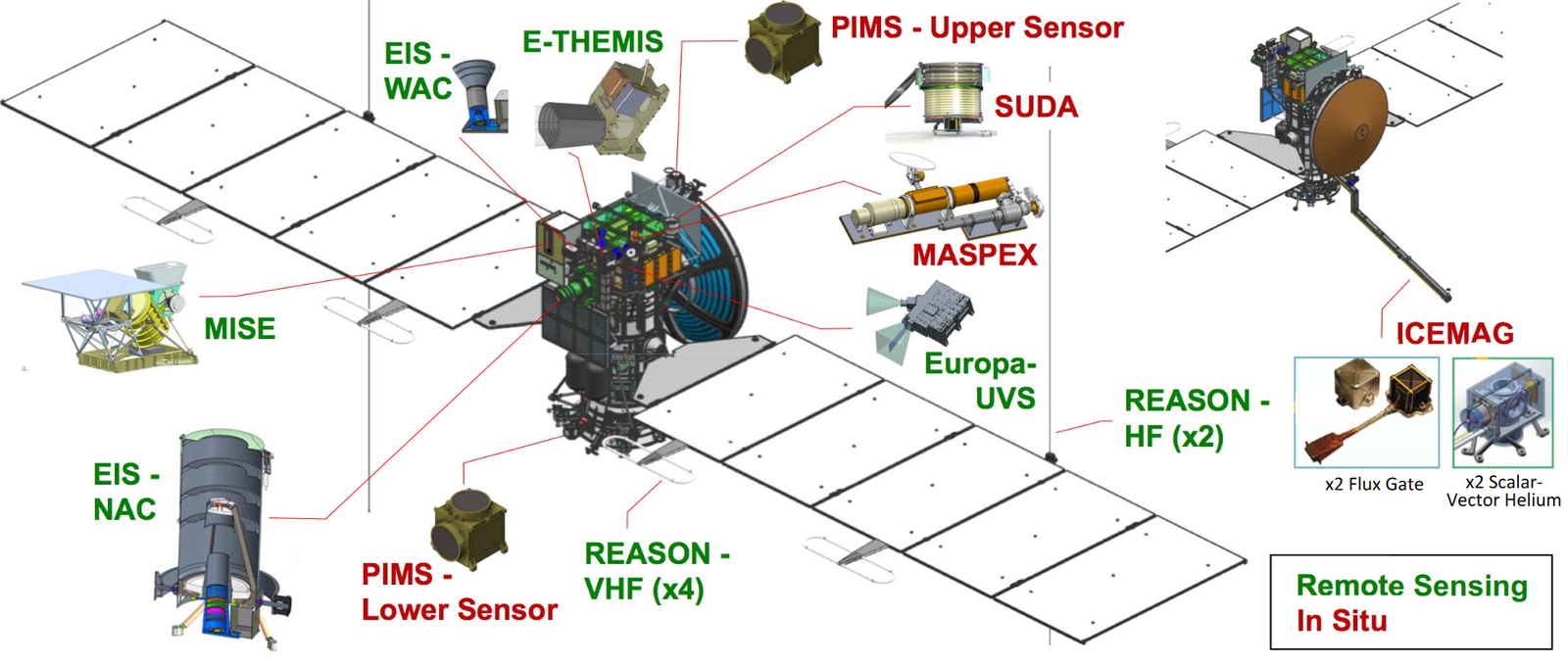Europa-Clipper-Diagram.png

Recently I wrote about the shortage of plutonium-238 which is used to provide power to U.S. satellites on deep space missions. Today, I am going to write about a different use of nuclear isotopes for space exploration.
NASA probes to Mars have included equipment to detect signs of current or ancient life on Mars. The scientists are not expecting to find anything more complex than singled celled life, if that. In analyzing the astronomical bodies in our solar system, it is thought that Europa, a moon of Jupiter may harbor more complex life. Some scientists think that there may be complex multicellular life there.
The surface of Europa is covered in ice that can be from a mile and a half thick to eighteen miles thick. It has been speculated that there may be a salty liquid ocean on Europa beneath the ice. We do not have definitive proof of the existence of such an ocean, but we have witnessed periodic eruptions of liquid water from the surface of Europa. NASA scientists believe that the best way to penetrate the ice to the probable ocean beneath Europa is by employing a nuclear power robot that could melt its way through the ice.
The Glenn Research Center at NASA is home to the multidisciplinary COMPASS team which was created to develop technology to meet the challenges of space exploration. The COMPASS team has carried out a conceptual study about technologies which would be able to penetrate the icy surface of Europa. They feel that a “tunnelbot” would be the best bet.
Nuclear energy is the most compact and efficient energy source that can be utilized for space exploration. The tunnelbot does not even have to contain a nuclear reactor although such a reactor was one of the possible designs that were produced by the study. The simplest design for the tunnelbot would be to contain bricks of radioactive material in a tube-shaped probe with a round tip. As the heat from the radioactivity turned the ice to slush beneath the probe, the probe would slowly sink down through the ice. A lander would drop the probe onto the surface of Europa and a cable containing fiber optic string to carry information back to the lander would be uncoiled behind the probe as it sank into the ice.
The tunnelbot would contain instruments that would take samples of the liquid water in the tunnel as the probe melted through the ice. It would also sample the underside of the ice if the probe reaches the predicted ocean as well as samples of the water-ice interface where the surface of the ocean meets the icy ceiling.
Associate Professor of Earth and Environmental Sciences Andrew Dombard from the University of Illinois at Chicago is a member of the COMPASS team. He said, “Estimates of the thickness of the ice shell range between 2 and 30 kilometers (1.2 and 18.6 miles), and is a major barrier any lander will have to overcome in order to access areas we think have a chance of holding biosignatures representative of life on Europa. We didn’t worry about how our tunnelbot would make it to Europa or get deployed into the ice. We just assumed it could get there and we focused on how it would work during descent to the ocean.”
The proposal for the tunnelbot was presented to the American Geophysical Union in Washington, DC this week by the COMPASS team. Now the proposal will go to Congress for possible inclusion in a future NASA budget. This may be difficult to accomplish. The main advocate for the tunnelbot project in Congress was Texas Republican John Culberson who lost his seat in the House of Representatives in the November election. President Trump has shown no interest in funding a Europa lander. On the other hand, Democrats now control the House of Representatives which is the place where all budget bills must originate. Democrats have been more prone to fund NASA projects than Republicans in the past.
Critics of the project say that it was more a matter of a project that some of the members of Congress wanted to fund than a project that could stand on its scientific merits alone. On the other hand, supporters of the project say that there would need to be a long lead time for such a project and it would be best to start working on such a project as soon as possible.
The Europa Clipper mission is a space probe that will fly to Europa and go into orbit around it. It will orbit Europa at altitudes as low as sixteen miles. The purpose of the mission is to map the surface of Europa in detail and to attempt to carry out a chemical analysis of the plumes of liquid water being ejected into space. The mission has received initial funding and it is hoped that it can be ready for launch by 2022. It will take six years for the probe to reach Europa and go into orbit.
The Europa Clipper mission might add important information to our knowledge of Europa that could be useful in the planning for a tunnelbot mission. Hopefully, Congress will find the will and the funds to begin work on the Europa tunnelbot mission soon.
There has been much speculation about the existence of life beyond the Earth. It would be a very important scientific discovery to find life and especially complex life in the oceans under the ice on Europa. It would certainly have a profound impact on our understanding of life and its origins. A big question will be just how much life on Europa would resemble life on Earth. If there is a complex ecosystem in the oceans of Europa, there is the question of how much damage the radioactive materials could do to the life under the ice.